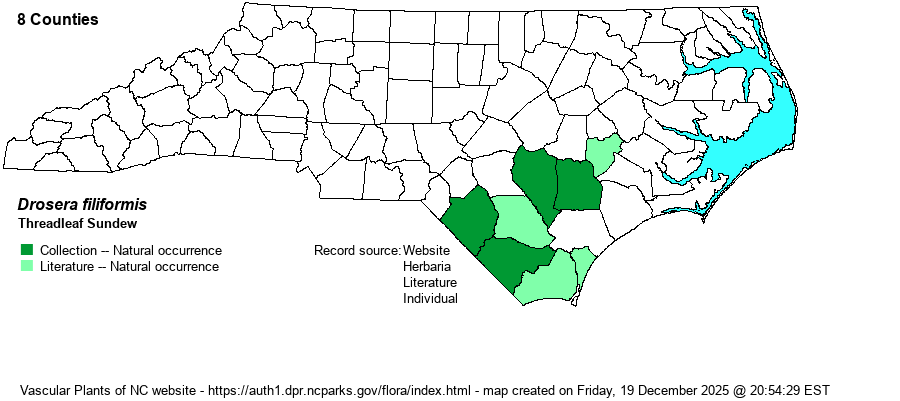| Author | Rafinesque | |
| Distribution | Found in the southern Coastal Plain, but not as far north and northeast as most other Coastal Plain sundews. It ranges northeast only to Duplin County, west to Robeson County, and south to the SC border, encompassing seven counties. A recent iNaturalist photo from Lenoir County, if not at a planted site, expands the range slightly in the state to the north.
This species is globally scarce and with an oddly disjunct range. It is a primarily Northeastern and coastal species, occurring in NS, from MA to MD, then in southeastern NC, and finally very locally in the FL panhandle. Apparently no records yet for VA. | |
| Abundance | Rare and local, though thankfully the NC NHP considers it still extant in all seven counties where recorded. It is a State Special Concern species, the only one of the five sundew species on such a state protected list. | |
| Habitat | Unlike most other sundews in the Coastal Plain, this is not a savanna species but is a species of quite damp acidic soil of pond margins, originally at natural ponds and pools such as clay-based Carolina bays. However, many populations now are in shallow pools of ditches, ruts or scrapes in powerline clearings, and other very shallow man-made wet ground. |
| Phenology | Blooms from late May into September, according to Weakley (2018); RAB (1968) simply says June. Fruits within a month or two after flowering. | |
| Identification | Though there is a very similar species outside of NC, within the state no other plant even remotely looks like this species. The strongly glandular and sticky leaves are filiform (extremely narrow), and grow vertically or angled upward. These 10 or more leaves reach 6-7 inches tall on average. The flowering scape grows about as tall of the top of a leaf, with an additional several inches of the spike of quite large bright pink flowers, the largest and most attractive of the genus. Each flower has a spread of about 2/3-3/4-inch across, though typically just one or two are in bloom at the same time on a given stalk. Thankfully, as with many sundews, this species usually grows in moderately dense colonies of 10-30 plants, and though one can easily walk by the plants if not blooming -- especially as the leaves are generally not red-tinged -- when a flower is fully open on the stalk it is very hard to overlook! | |
| Taxonomic Comments | This has always been a good species, but the more southern D. tracyi has often been considered as a subspecies or variety; most references treat it as a good species now. However, there are at least two varieties of D. filiformis; that in NC is the nominate one -- D. filiformis var. filiformis, which is not recognized as valid by NatureServe.
| |
| Other Common Name(s) | None | |
| State Rank | S2 | |
| Global Rank | G4 | |
| State Status | SC-V | |
| US Status | | |
| USACE-agcp | OBL link |
| USACE-emp | OBL link |

